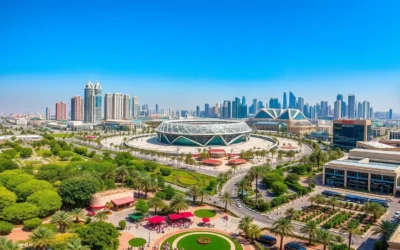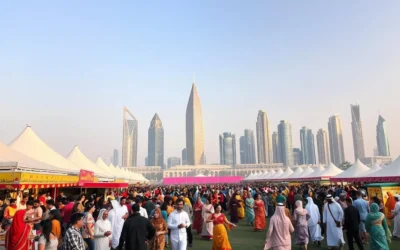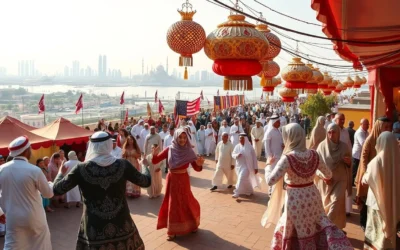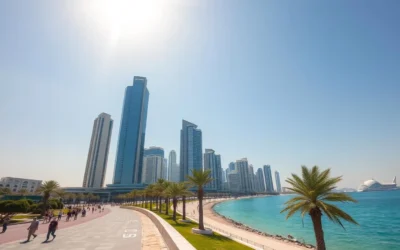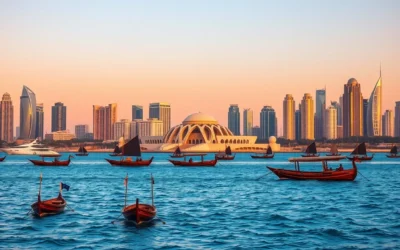✓ Accommodations ✓ Flights ✓ Rental Cars ✓ Tours & Activities
This country is a fascinating blend of cultures, reflected in its rich linguistic tapestry. Arabic stands as the official language, deeply rooted in its history and culture. It is the primary language used in government, education, and daily life, connecting its citizens to their heritage.
With a population of over 2.6 million, the country is home to a vibrant mix of people from around the world. This diversity brings a variety of languages, including English, which plays a significant role in business and international communication. Other languages like Urdu, Tagalog, and Farsi are also widely spoken, reflecting the multicultural community.
Whether you’re exploring the bustling cities or engaging with local traditions, you’ll notice how languages shape interactions. From Gulf Arabic dialects to multilingual road signs, the country embraces its linguistic diversity. Join us as we delve deeper into how language connects people in this unique part of the world.
Understanding Qatar’s Linguistic Landscape
The linguistic landscape of this nation is shaped by its diverse population and rich history. With a population of over 2.6 million, the country is home to a vibrant mix of people from around the world. This diversity brings a variety of languages, including English, which plays a significant role in business and international communication.
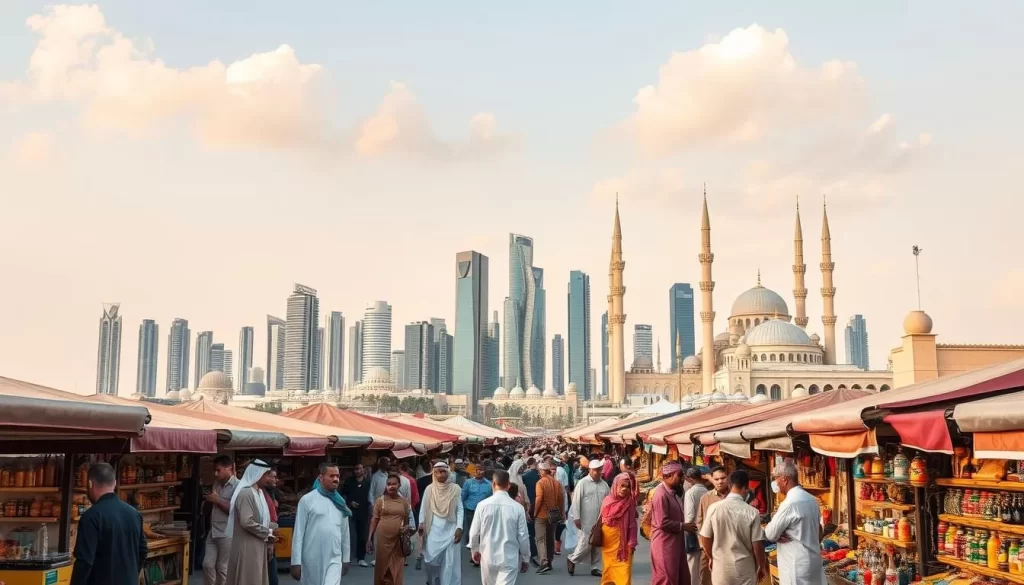
Population and Cultural Diversity
The country’s population is a melting pot of cultures. Native citizens make up approximately 11% of the total population, while expatriates form the majority. This mix has led to a rich linguistic environment where languages like Hindi, Urdu, and Tagalog are commonly spoken alongside Arabic.
Expatriates often use English as a lingua franca, fostering unity and collaboration among diverse groups. This has made English a key language in business, education, and daily interactions.
Historical Roots of Language Use
Historical migrations and trade have deeply influenced the language roots in this region. Arabic, the official language, has evolved into various dialects, including Gulf Arabic, which is widely spoken.
Neighboring regions like Saudi Arabia and the United Arab Emirates have also contributed to the local dialects. Many Arabic terms from these areas have been integrated into everyday speech.
“Language is the road map of a culture. It tells you where its people come from and where they are going.”
| Language | Usage |
|---|---|
| Arabic | Official language, government, education |
| English | Business, international communication |
| Hindi/Urdu | Expatriate communities |
| Tagalog | Expatriate communities |
The government and community play vital roles in maintaining language traditions. Efforts are made to preserve Arabic while embracing the benefits of multilingualism. This balance ensures cultural identity thrives in a globalized world.
Arabic: The Official and Enduring Language
Arabic stands as the cornerstone of communication in this region, deeply embedded in its cultural fabric. It serves as the official language, connecting people to their heritage and traditions. Whether in formal settings or daily interactions, Arabic plays a vital role in shaping the identity of this area.
Standard Arabic vs. Gulf Arabic
In this region, you’ll encounter two main forms of Arabic: Standard Arabic and Gulf Arabic. Standard Arabic is used in formal contexts like education, media, and legal documents. It’s the language of literature and official communication.
Gulf Arabic, on the other hand, is the dialect spoken in everyday life. It differs in pronunciation and vocabulary, reflecting local influences. This dialect is a key part of the area’s linguistic identity, making it unique among Arabic-speaking regions.
Arabic in Education and Government
Arabic’s role in education is significant. It’s the primary language of instruction in schools, ensuring students connect with their cultural roots. The literacy rate here is 89%, reflecting the emphasis on learning.
In government, Arabic is the language of law and administration. Legal documents, official communications, and public services all rely on it. This ensures consistency and clarity in governance.
“Language is the soul of a nation, preserving its history and guiding its future.”
Arabic’s enduring presence in this region highlights its importance. It’s not just a language—it’s a bridge between the past and the present, uniting the community and preserving its heritage.
Qatar: Official and widely spoken languages
In this vibrant area, language bridges tradition and modernity, shaping daily life. Arabic, the official language, remains central to cultural identity, while English facilitates global connections. This balance ensures that both heritage and progress thrive side by side.
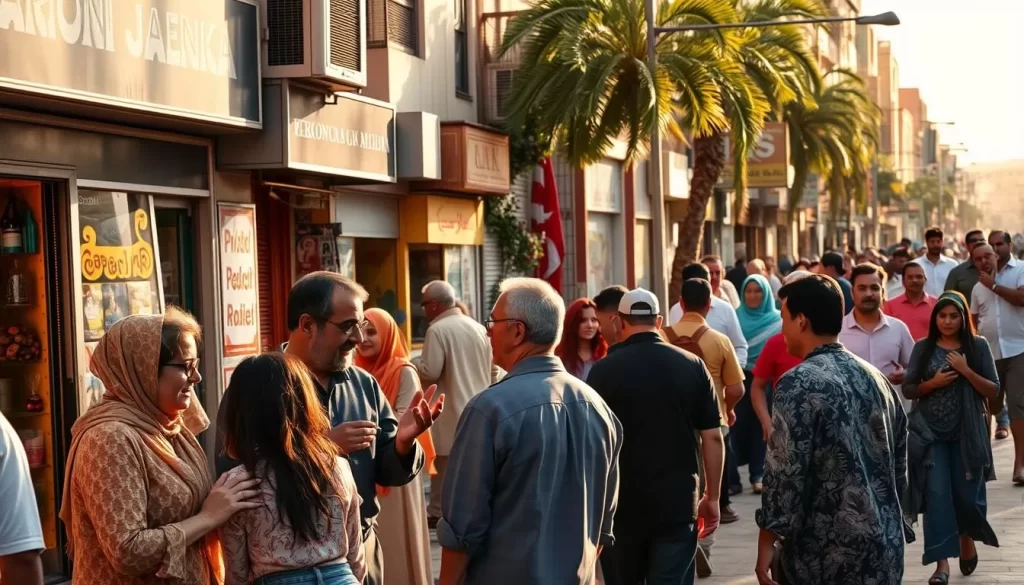
Role of Arabic and English in Daily Life
Arabic dominates formal settings, from government offices to educational institutions. It’s the language of laws, media, and local traditions, preserving the region’s cultural roots. In contrast, English is widely used in business and international communication, making it essential for expatriates and global partnerships.
Bilingual signage is a common sight, reflecting the coexistence of both languages. Road signs, menus, and public announcements often feature Arabic and English, catering to the diverse population. This practice ensures clarity and inclusivity for residents and visitors alike.
At home, families often switch between Arabic and their native tongues, creating a multilingual environment. This flexibility fosters a sense of belonging while embracing global influences. In workplaces, English serves as a lingua franca, uniting people from different backgrounds.
| Language | Primary Use |
|---|---|
| Arabic | Government, education, local traditions |
| English | Business, international communication |
| Hindi/Urdu | Expatriate communities, daily interactions |
| Tagalog | Expatriate communities, family settings |
This linguistic harmony supports both local traditions and global outreach. It ensures that the community remains connected to its heritage while embracing the benefits of a modern, interconnected world.
Embracing Multilingualism and Cultural Exchange in Qatar
The vibrant mix of cultures in this region creates a unique linguistic environment. With a population of over 2.8 million, the area is home to a diverse community of expatriates and locals. This diversity has led to a rich tapestry of languages, fostering cultural exchange and unity.
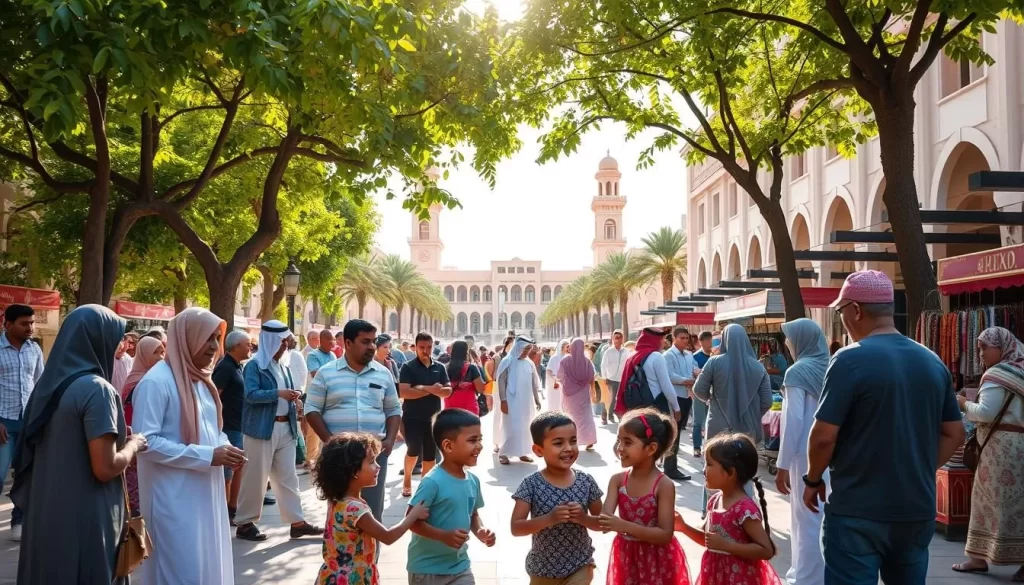
Languages of the Expatriate Community
Expatriates bring their native tongues, enriching the local culture. Tagalog, Urdu, and Malayalam are widely spoken, reflecting the influence of South and Southeast Asian communities. These languages shape daily interactions, both socially and professionally, creating a dynamic linguistic landscape.
For instance, the Primary Health Care Corporation’s helpline offers support in Malayalam, Tagalog, Urdu, English, and Arabic, ensuring accessibility for all. This inclusivity highlights the importance of multilingualism in fostering a connected community.
Immigrant Languages Shaping Local Identity
Immigrant languages play a vital role in reinforcing local identity. Urdu and Tagalog, for example, are not just spoken at home but also integrated into public spaces and business settings. This blend of languages creates a unique dialect that reflects the area’s multicultural essence.
As highlighted in a study on multilingualism, such linguistic diversity promotes awareness and inclusivity, moving beyond traditional monolingual approaches.
Qatar Unified Sign Language
Efforts to bridge communication gaps include the development of Qatar Unified Sign Language. This initiative aims to support the deaf community, ensuring they are included in all aspects of society. It’s a step toward fostering a more inclusive environment where everyone can thrive.
As noted in research on language and identity, such efforts highlight the importance of preserving cultural heritage while embracing modern communication tools.
This mosaic of languages not only enriches cultural dialogue but also strengthens unity. It’s a testament to how multilingualism can bridge divides and create a harmonious community.
Impact on Business, Education, and Community Engagement
Language diversity in this region drives economic and educational progress. The strategic use of multiple languages fosters innovation and strengthens global ties. This approach has transformed the way businesses operate, schools teach, and communities connect.

English and Global Communication
English serves as a lingua franca in business transactions and international diplomacy. It’s the primary language for global partnerships, making it essential for economic growth. Companies here rely on English to communicate with international clients and investors, ensuring seamless collaboration.
In education, English is a key component of the curriculum. The implementation of the English Medium of Instruction (EMI) policy in 2003 aimed to prepare students for a globalized world. However, challenges like varying proficiency levels have led to debates about its effectiveness.
Economic Growth Intertwined with Language Diversity
Multilingualism is a cornerstone of this region’s economic success. Expatriates, who make up 88% of the population, bring diverse language skills that enhance workforce productivity. This linguistic diversity supports industries like construction, healthcare, and technology, driving innovation and efficiency.
Government policies also play a role. By promoting bilingual education and culture exchange, the region ensures that both locals and expatriates contribute to its growth. This approach has helped build a knowledge-based economy, aligning with its 2030 national vision.
“Language is the bridge between tradition and modernity, connecting people to opportunities.”
For more insights on how language shapes identity and education, explore this study. It highlights the balance between preserving cultural heritage and embracing global communication.
Conclusion
This country thrives on its unique blend of language and culture, creating a harmonious environment. Arabic remains central to its identity, while English bridges global connections. This balance supports both tradition and modernity.
Multilingual practices unite the community, fostering inclusivity. From business to daily interactions, diverse dialects enrich the social fabric. Such diversity strengthens economic growth and cultural exchange.
Explore how this linguistic blend shapes every aspect of life. For deeper insights, visit this resource. Embrace the profound impact of language in connecting people and preserving heritage.
The above is subject to change.
Check back often to TRAVEL.COM for the latest travel tips and deals.
Here are some Tours & Sightseeing suggestions that might pique your interests!

